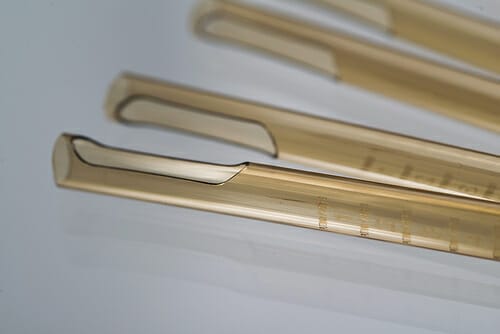
Why would you choose UV laser machining?
Ultraviolet (UV) laser machining is a non-thermal material removal process that utilizes high resolution, short wavelength light. This allows for medical devices to be manufactured with the smallest features in accordance with the most demanding specifications, with a process that is reliable and repeatable. Applications in medical catheter design include drug delivery access ports, selective removal of material, position markings, and drug delivery openings.
What are the exceptional properties of laser machined medical plastics?
Our state-of-the-art nanometer UV laser technology can produce precision openings in thin wall catheters. These include square, round, oval or irregular shaped blind holes or through holes. Arrays of hundreds or even thousands of precision holes can also be created.
What are the advantages of laser machined tubing?
Putnam utilizes the latest in short pulse laser technologies that offer several advantages over standard mechanical cutting operations for the manufacture of medical catheters:
- Tight tolerances – cutting patterns on medical catheter components are repeatable and reliable to dimensions as small as 0.0002 inches (0.0050 mm).
- Complex patterns – our 2-axis and 4-axis lasers can cut precision patterns on thin wall catheter tubing.
- Precision cuts – cutting lasers are well suited for clean cuts on catheter components that cannot be easily obtained by mechanical cutting methods. For example, laser cutting allows for clean, perpendicular cuts on braid and coil reinforced medical catheter tubing.
- High performance materials and components – laser cutting is a highly effective option for cutting high performance materials, such as PEEK and polyimide, as well as small precision parts, such as polymer marker bands for medical catheters and stainless steel hypotubes.
Which materials are typically laser machined for medical catheters?
Our nanometer ultraviolet (UV) cutting laser is capable of custom drilling, cutting and marking polymer components made from extremely hard polymers, such as polyimide or PEEK, as well as delicate materials.
Which medical devices or procedures are laser machined plastics commonly used in?
Laser machined medical plastics are used in a variety of critical medical device components and procedures, including:
- introducers and dilator sheaths,
- minimally invasive devices used in cardiovascular, neurosurgical and ophthalmologic procedures,
- cardiovascular and neurovascular stents,
- drug delivery systems, and
- other flexible catheter shafts.
What ISO certification does Putnam have?
Putnam’s leading-edge extruded tube manufacturing facility is ISO 13485:2016 certified. Our dedicated clean room manufacturing space meets the growing demand of industry codes and regulatory guidelines.

Why is Putnam the best choice for laser machined medical plastics?
Putnam’s advanced laser technologies can expedite to market your most complex medical tubing configurations.
As a global tubing supplier and a specialist in high-tech extrusion with precise finishing capabilities, Putnam can leverage over 40 years of custom manufacturing to design and engineer the best medical tubing to meet your functional requirements, with the most cost-efficient material and technology available.
